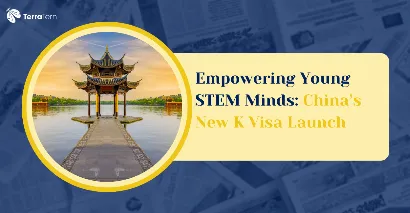Key Highlights
China is set to redefine its approach toward global talent with the debut of a new K visa, zeroing in on young scientists and technologists. This visa will go into effect on October 1, 2025, and significantly serve as a milestone in the achievement of the country toward attracting new STEM talent by giving them more flexibility, fewer barriers to their entry and more opportunities to innovate. The fact that previous sponsorship by the employing firm is not required means that the K visa is an indication of China's willingness to allow young innovators into its already fast-developing innovation system.
What Is the K Visa & Who Is Eligible?
The new K visa is specifically designed to suit foreign-born young professionals in STEM disciplines, i.e. at least high school graduates working towards a degree in any department of science, technology, engineering and mathematics or may be at a university or working to do some research in that recognised department.
Although the specifics of eligibility, such as the upper-age requirements, are not fully confirmed as of yet, sources indicate a resemblance to similar programs currently in effect: The Talented Young Scientist Programme limits its applicants to around age 45, whereas the Outstanding Young Scientists (Overseas) Fund Project also limits itself to around age 40.
Also Read: Difference Between Tourist Visa and Visitor Visa
Why Is China Doing This Now?
China is doing this due to the following reasons:
-
Talent Policy
The push of these visas supports a broader Chinese innovation agenda in which science is the main productive power, talent the main asset and innovation the main power. The K visa highlights the strategic shift in favour of active, transparent and successful international talent recruitment.
-
World Skill Challenge
With other countries toughening up on immigration, China is positioning itself as a home to young talent seekers, a decision that might transform the world in terms of global mobility of talent.
-
Reverse Brain Gain & Domestic Needs
The K visa will allow foreign STEM professionals or overseas Chinese scientists an easy entry with respect to collaboration, research, or entrepreneurship in China, thus contributing to the national development and talent repatriation.
How the K Visa Stands Out?
K visa stands out in the following way:
|
Feature |
K Visa |
|
No domestic sponsor required |
Foreign applicants need not have a Chinese employer or invitation. |
|
Streamlined process |
Less bureaucratic hassle compared to existing visa types. |
|
Enhanced flexibility |
Better terms for multiple entries, validity, and duration of stay. |
|
Broad activity scope |
Allows engagement in education, research, culture, entrepreneurship, and business |
Policy Background & Framework
The K visa is based on an amendment to the Regulations on the Entry and Exit of Foreigners, which became effective through the State Council Order No. 814.
As of October 1, 2025, the K visa would be a thirteenth category of ordinary visas, alongside the classics, Z (work), X (study), and M (business).
The applicants should give qualifications according to instructions, which would be provided by the Chinese authorities and provided at the embassies and consulates.
Also Read: Top 10 Visa Rejected Reasons: Know Latest Changes
Potential Benefits for China
-
Tapping Early-Career Talent: opening up the possibility of young scientists and entrepreneurs with no formal job offer, but with fresh potential.
-
Greater Regional Geographic Impact: Beyond a megacity like Beijing or Shanghai, there could be flows of external talent to regional centres of innovation under the K visa.
-
Global Soft Power: China has been a beneficiary of the K visa, as it has the soft-power aspect of welcoming brilliant minds in the face of geopolitical rivalry.
-
Reverse Brain Gain: Streamlined channels could also attract Chinese professionals working abroad into a short-term or long-lasting engagement.
Challenges & Caveats
The challenges and caveats are:
-
Definitional Clarity: Young, science, and technology talent are terms that need to be given clear definitions just to eliminate malpractices and discrimination.
-
Integration and Retention: It is not merely about entry, but rather, establishing an enabling environment to innovate, build communities and/or retain individuals on a long-term basis where possible.
-
Security & IP: There are sophisticated areas at play, so finding the right balance between open and IP will be essential.
-
Quality in Application: The actual effectiveness of the visa would be compromised in case the application procedure is ambiguous or inefficient.
Trends Ahead: What to Watch?
-
Clear Guidelines: Authorities will post out requirements, documents, and the application process way before October 1.
-
Local Benefits: Major cities can also initiate additional perks, in the form of grants, housing, or startups, to appeal to K visa recipients.
-
Following the Rollout, Efforts might be measured in terms of uptake levels, feedback and effects on local innovation ecosystems.
Also Read: Exams to Study Abroad: The Complete Updated Guide
Conclusion
Chinese K visa has the ability to become a mood changer in the world in terms of competition to attract talent in STEM fields. It will start on October 1, 2025, and provide a peculiarly adaptable and streamlined pathway into China, all without the need for a host employer. When properly executed and accompanied by favourable integration policies, it may strengthen innovation, broaden source talents, and make China a new, active and open centre of early-career scientists, scholars and technological businesses. Whether it is successful or not will depend on its articulate clarity and its execution efficiency, and how China can make use of the young global talent that it attracts.
Contact TerraTern for more information on China’s new K visa.








